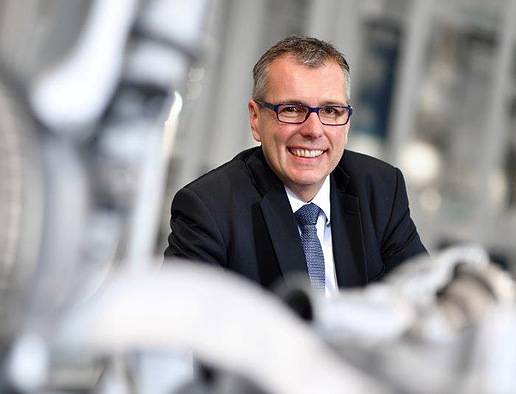 采埃孚汽车底盘技术负责人Holger Klein博士。
采埃孚汽车底盘技术负责人Holger Klein博士。
2015年,采埃孚集团(ZF)成功收购美国天合(TRW),超级巨头一夜崛起。凭借两家公司在行业领域、财务方面和电子技术方面的实力,合并后的新公司将给全球所有其他主要一级供应商带来严峻挑战。
由于两家公司也采用了“戴姆勒-克莱斯勒”式的“对等合并”,部分观察人士可能会质疑采埃孚的收购逻辑,或者说这两家集团的公司文化是否存在致命性差异。
不过,采埃孚汽车底盘技术部门负责人Holger Klein博士认为,这两家公司拥有共同的愿景,强强联手有百利而无一害。“归根结底,本次合并的动因是‘我们想为客户提供完整的底盘系统’,而天合可以提供我们所不具备的部件和技术能力。”Klein在最近一次与《国际汽车工程(AEI)》的采访中表示,“我们两家公司均着眼于安全、效率和自动驾驶等方面的发展,彼此的产品结构也相当互补。”
采埃孚也许还可以选择收购拥有类似背景的小型公司,但对于天合,本次收购则是一个可以帮助公司实现强大技术协同效应的“千载难逢的机会”。据了解,本次收购的内容也包括Klein博士领导的汽车底盘系统部门,该业务部拥有近16,000名员工,市值达60亿美元。
Klein博士表示,无论是悬挂、连杆、结构部件、球形接头,还是稳定系统,未来,我们部门的所有产品均将成为“智能”的机械部件。他提到,“我们认为,真正控制车辆的侧向、纵向和垂直动力性能及方向的是汽车底盘。那么,如果你想在该领域内获得成功,成为真正的技术领导者,就一定要将这些组件整合至车辆的机械系统之中。”
处理器速度存在挑战
采埃孚对天合的收购“极大地”增强了集团的技术实力,Klein博士表示,“如果单独讨论底盘技术本身,我们的确将转向系统合资公司的股份出售给了博世(Bosch),但我们也获得了天合的转向技术,而且事实上天合的技术更适合集成至我们的产品中。制动系统对车辆的纵向动力性能非常关键,而基于摄像头、雷达等传感器技术的高级驾驶辅助系统(ADAS)和主动安全技术也必不可少。这一切都可以协助我们顺应大趋势,迈入自动驾驶汽车的未来。”
可以说,电子元件与机械、液压系统的融合,将成为汽车行业面对的最大挑战之一。然而,Klein博士却认为,车载处理器有限的计算能力才是行业首先应当面对的首要瓶颈。他说,“我们必须找到一种解决方法。”目前来说,车载计算机首先必须完成图像识别和轨迹计算,接着进行判断,之后才能指挥促动器完成无论任何操作。
Klein博士解释道,“这个过程是以毫秒计算的,而且通过制动e-booster或偏航控制等电气化技术实现促动器加速,将进一步缩短所用的时间。”
很显然,人工智能的出现将成为使能自动驾驶未来的关键因素,而采埃孚将与英伟达(Nvidia)合作,从2018年开始研发、生产ZF ProAI 人工智能处理器。
Klein博士表示,“大家总是在讨论车内到底需要多少计算机或ECU,该向 ECU中集成哪些模块,又需要什么级别的处理能力,然而,在我们的视角中,目前,在紧急情况下,车辆的车载计算机处理能力已经达到了一定极限,而厂家又是否愿意牺牲多媒体系统的配置,以换取为这些复杂算法多争取到的几毫秒时间?很显然,我们需要更加强劲的车载计算机平台。”
为X-by-wire线控做好准备
本研发项目的一个重要特点,在于推出了一个48V混动电系,进而支持自动驾驶系统及其他一些目前采用机械或液压驱动的车辆系统。
“我们认为,线控技术一定可以协助我们实现新一代促动系统的开发,”Klein博士预测,“目前的挑战在于将如何设计冗余系统、展示故障安全机制,确保这些电子系统已经通过全面验证。此外,一些相关法规也需要进行相应修改。”
此外,尽管Klein博士承认,电动交通出行解决方案的确“有助于”降低市内的CO2等排放,但最简单的方法仍是采用油电混合系统。“我们都是工程师,也一直在考虑油电混合是否是最有效的解决方案,我的答案是肯定的。”不过,Klein博士也同时承认,无论是从热效应、减重还是封装方面来看,为车辆配备两套推进系统的确都不是最理想的选择。
Klein博士表示,“最大的挑战在于,判断哪些技术解决方案可以提供合理的续航里程、满足客户需求,而且有能力实现碳中性目标。”
Klein博士认为,这种不断增加的精密度和复杂度背后隐藏着“巨大的”成本压力,但可能很多全球立法者并不会考虑这个问题。他说,一夜之间从一种技术转到另一种技术总是“一种巨大的挑战”,特别是对于汽车行业这样一个可能做决定需要5年时间,真正推进技术需要15年时间的保守行业。
ZF’s takeover of TRW in 2015 sent shockwaves through the industry by over night creating a mega global business with the industrial and financial clout and electronics capability to challenge the top Tier 1s.
Some observers might have questioned the takeover’s logic or whether the cultural differences might prove destructive, as they were in the Daimler-Chrysler “merger of equals.”
But Dr. Holger Klein, head of ZF's Car Chassis Technology group, sees nothing but benefits from two businesses sharing similar visions joining forces. “At the end of the day the rationale behind the deal was industry logic where you say, ‘I want to offer the complete chassis’ and missing components on our side were complemented by components and know-how from TRW," he said during a recent interview with Automotive Engineering. "The vision is the same, centered around safety, efficiency and autonomous driving. The components were very complementary."
ZF could have bought smaller companies with similar expertise, but the TRW opportunity was "a once in a lifetime opportunity" for a mighty technology synergy—including in Dr. Klein's chassis systems domain, a €6B business with 16,000 employees.
He said all of the division's products—including suspension, linkages, structural parts, ball joints and stabilizers—are becoming “intelligent” mechanical components. “What we say is that the chassis controls the vehicle’s lateral, longitudinal and vertical dynamics as well as its guidance. If you want to be successful in this area and be a technology leader you really need to combine these components into mechanical systems," he noted.
The processor-speed challenge
ZF’s acquisition of TRW expanded its technological capability “enormously,” said Klein, “If you 'peel the onion' and talk about the chassis technology itself, we lost the steering systems joint venture with Bosch but we got steering technology from TRW which, by the way, is very much integrated into the business. The braking side is very important for longitudinal dynamics and then this entire arena of ADAS [advanced driver assistance systems] and active safety which helps us a lot with sensor technology like cameras, radar, etc. This all comes in together in what we need to serve the mega trend of autonomous-driving cars.”
It is this melding of electronics with mechanical and hydraulic systems that is, arguably, one of the big challenges facing the industry. Dr. Klein, however, argues that it’s the computing power on-board the vehicle which is proving more of a bottleneck than the other systems. "We have to develop strategies to counter this," he said. Computers need to translate image recognition and calculate trajectories to define a strategy that can prime the actuators ahead of any eventuality.
"We’re talking milliseconds here and speeding up actuators through electrification, like a braking e-booster or yaw control, will improve reactions even more,” Dr. Klein explained.
Clearly the emergence of Artificial Intelligence will be key to future autonomous driving strategies as ZF’s deal with Nvidia to develop and produce the ZF ProAI processor from 2018 onwards demonstrates.
“There always was a discussion of how many computers or ECUs we need in a car," he said, "and what do you integrate into the ECUs and what kind of computing power do you need? What we see is that we’re already reaching certain limits of our computing power if the car is in an emergency situation. Do you need to ramp down the multi-media system just to get a few more milliseconds of computing power to solve these complex algorithms? There’s a clear need for more powerful platforms than we have today.”
Preparing for X-by-wire
An intrinsic element of this development will be the roll-out of 48-volt hybrid systems as an enabling technology for both autonomous driving systems and other technologies within vehicles that are currently mechanically or hydraulically powered.
“We actively see the electrics driving us to the next generation of actuation which will certainly be X-by-wire," Dr. Klein forecast. "The challenge will be how do you create redundancies and show the fail safe mechanisms and make sure the electrics are really proven? There’s also a need for legislation to be updated to allow for these developments to happen.”
Whilst he concedes that electromobility “helps” with city driving in lowering CO2 and other emissions, Dr. Klein believes the easiest solution is a hybrid. "I think there is no way round hybrids, although we are all engineers and we doubt if that is the most efficient means of solving the issue." He concedes that having two propulsion systems on board is not a thermodynamic optimum, nor is it a mass and packaging ideal.
"The big challenge is which technological solutions will deliver the right range, meet customer demands and is CO2 neutral?” he said.
Underlying this growing sophistication and complexity is "enormous" cost pressure, which Dr. Klein believes global legislators don't always consider. Shifting from one technology to another overnight presents "a huge challenge" to an industry that makes decisions that won’t materialize for five years and won't be amortized for another 15 years, he said.
Author: Ian Adcock
Source: SAE Automotive Engineering Magazine
等级
打分
- 2分
- 4分
- 6分
- 8分
- 10分
平均分
- 作者:Ian Adcock
- 行业:汽车
- 主题:零部件车辆底盘与飞机起落架电气电子与航空电子
